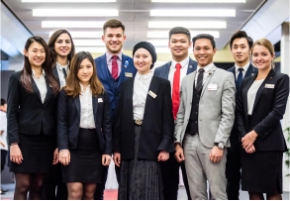- About
- Programs
- Campus life
- Career Services
- Admissions
- News & Events
- Alumni
Exploring Asian Hospitality: Cultural Insights & Practices
Explore the traditions and practices of Asian hospitality. Learn how cultural insights shape hospitality across Asia. Start your journey today!
Key Takeaways
- Asian hospitality blends traditional values with modern influences, drawing from cultural philosophies like Confucianism, Buddhism, and Hinduism while integrating contemporary trends such as AI-powered services and sustainable practices.
- Every Asian country has distinct hospitality customs shaped by cultural identity, from Japan’s Omotenashi and China’s emphasis on honor to India’s deep-rooted tradition of treating guests with reverence under “Atithi Devo Bhava.”
- Modern hospitality trends in Asia prioritize innovation and well-being, incorporating smart hotel technologies, eco-friendly practices, and wellness tourism.
Culture has always been intertwined with hospitality, and it heavily influences how establishments in this field approach their guests and offer services. In Mediterranean cultures, for example, hospitality often revolves around seafood and communal gatherings. In Scandinavian countries, hospitality leans toward a more minimalistic and functional approach.
Asia, being home to some of the world's oldest civilizations and a range of cultures, has developed a hospitality ethos that is both warm and service-oriented, often reflecting strong family values and a commitment to harmony.
Yet, at the same time, Asian hospitality is characterized by its ability to blend its deep-rooted traditions with modern global hospitality standards, balancing cultural warmth and professional efficiency.
Cultural Insights Into Asian Hospitality
In the book “Foreign to Familiar: A Guide to Hot and Cold Climate Cultures,”, the author, Sarah Lanier, introduces the concept of hot and cold cultures, exploring how different societies interact, communicate, and offer hospitality.
According to Lanier, hot-climate cultures, typically found in warmer regions such as Latin America, Africa, and parts of Asia, emphasize relationships, indirect communication, and a much more personal approach to hospitality.
On the other hand, cold-climate cultures are commonly associated with Northern Europe and parts of East Asia. They are seen as regions that focus more on efficiency, punctuality, and structured interactions, where personal space and professionalism are prioritized.
While the Asian hospitality industry is generally regarded as having strong hot-climate influences, it is difficult to categorize the entire continent under one classification. Some regions, such as South and Southeast Asia, align more with generosity, elaborate greetings, and community-centered service.
In contrast, East Asian countries like Japan and South Korea have integrated cold-climate elements, emphasizing precision, structured etiquette, and professionalism while maintaining a warm, service-oriented mindset.
This fusion of styles makes Asian hospitality distinct—it retains the emotional depth and familial warmth of hot cultures while incorporating the discipline and structure often associated with cold cultures.
The hospitality traditions found across Asia are usually rooted in cultural values, philosophies, and social norms that have been passed down for generations. While specific customs vary from country to country, several overarching themes define the way hospitality is practiced throughout the continent.
One of the strongest influences on Asian hospitality is the deep-rooted value of family and filial piety that emphasizes respect for elders and the prioritization of communal, especially family, well-being over individual desires.
In many Asian cultures, hosting guests is seen as an extension of these family values—visitors are often treated with the same level of care and deference as elder relatives, ensuring they feel welcomed and valued.
Food is also a fundamental aspect of hospitality in Asia. Meals serve as a way to strengthen relationships and express care for guests. Communal dining traditions—such as the use of large round tables with shared dishes in many cultures—emphasize togetherness and generosity.
Hospitality Practices in Key Asian Countries
Asian hospitality is as diverse as the cultures that influence it. Each country has specific customs that define its hospitality practices, with some of the most noticeable and unique cases being in:
Japan
Nothing embodies hospitality in Japan more than Omotenashi—a philosophy rooted in selfless service and attention to guests’ needs. This approach to hospitality can be seen in various aspects of Japanese life, from traditional ceremonies to high-end hotels, restaurants, and even retail environments.
One of the most unique demonstrations of Omotenashi is the tea ceremony, or sado, a centuries-old tradition and a ritualized form of hospitality where the host carefully prepares and serves tea with precision and grace to make the guest feel at ease.
Another setting where Omotenashi can be observed in action is in Ryokans, which are traditional Japanese inns. In these settings, guests experience a level of service that surpasses typical hospitality standards, from arrival when they are greeted with a warm welcome that often involves a bow and a carefully prepared kaiseki (multi-course meal) to the arrangement of rooms and the farewell.
Japanese hospitality is less about grand gestures and more about perfecting the small details that make a guest feel genuinely cared for.
China
Chinese hospitality is largely influenced by Confucian values, where there is a significant emphasis on respect, honor, and collectivism. Whether in a restaurant, hotel, or home, hosts take great pride in making visitors feel valued and comfortable.
In China, the concept of ”face” (mianzi) is important since a host's reputation is closely tied to how well they treat their guests. Hosts will therefore go out of their way to serve the best food, offer gifts, and anticipate guests' needs.
Hotels and restaurants extend that same level of attentiveness, making sure that their guests feel welcome from the moment they arrive. During the check-in process, it is common for hotel staff to personally escort guests to their rooms to ensure that they settle in comfortably.
The farewell experience is just as important. In many places, simply checking out of a hotel or finishing a meal is not the end of the interaction. Guests may be escorted to their transport or even given a small farewell gift, reinforcing the sense of thoughtfulness that defines Chinese hospitality.
India
The phrase “Atithi Devo Bhava,” which translates to “The guest is God,” reflects the very essence of Indian hospitality. It's a belief that is reflected in everything from traditional welcome rituals to the grandeur of Indian festivals.
In many households and hotels, guests are greeted with an aarti, a traditional ceremonial blessing where a lamp is waved in front of them to ward off negative energy. Another common gesture is placing a bindi (a decorative dot) on the guest's forehead, which represents good fortune and respect.
These customs, while deeply rooted in tradition, continue to be practiced widely today, especially in cultural events and religious ceremonies.
Diwali, the festival of lights, and Holi, the festival of colors, are among the grandest occasions. These festivals are an opportunity for people to show generosity, reconnect with loved ones, and embody the spirit of Indian hospitality in its purest form.
Thailand
Thailand is yet another Asian country that is widely recognized for its warm and welcoming approach to hospitality, earning the nickname “The Land of Smiles.” Whether in luxury hotels or street-side eateries, guests are greeted with genuine warmth, reflecting the country’s deep-rooted culture of positive social interactions.
Thai hospitality is built on cultural values of kindness, patience, and a relaxed attitude toward life. A signature aspect of it is the “Wai” greeting—a gesture in which hands are pressed together in a prayer-like position and accompanied by a slight bow. This act is a sign of respect and gratitude in Thai culture and is commonly used when welcoming guests or thanking them.
Another key concept in Thai hospitality is the “Mai Pen Rai” philosophy, which translates roughly to “It's okay” or “Don't worry.” It's an attitude that reflects Thailand’s easygoing and accommodating approach to service, where hosts and staff strive to help guests feel relaxed and unburdened by formalities.
Korea
Korean hospitality is also influenced by Confucian values and uses them to guide everything from dining customs to the way guests are treated in homes and businesses.
A major aspect of Korean hospitality is communal dining, which fosters bonding among guests. Traditional meals include a variety of small side dishes that are shared, creating a sense of community.
Another common practice is for guests to offer tea or refreshments upon arrival. Whether in a home or professional setting, it is customary for the guests to be welcomed with warm tea, symbolizing hospitality and care.
Korean hospitality is also reflected in the use of honorific language. The way a guest is addressed and spoken to depends on their age and social status, reinforcing the importance of showing respect in all interactions.
How Cultural Practices Shape Hospitality
Cultural practices shape hospitality because the latter is an extension of a country's cultural identity. Cultural traditions influence how hospitality is practiced across the world, and Asia is no exception. Cultural pride and heritage are often expressed through hosting, making hospitality a direct reflection of a country's traditions and values.
Many Asian cultures emphasize respect, harmony, and selfless service, values that stem from long-standing philosophical and religious traditions. In addition to Confucianism, which influences hospitality etiquette in East Asian countries, Buddhism and Hinduism emphasize compassion, generosity, and interconnectedness, thus reinforcing the idea that hospitality is about service and creating a welcoming environment for guests.
Modern Trends in Asian Hospitality
Although tradition is a big part of Asian hospitality, the industry has also embraced modern technology, such as the integration of AI in hospitality, to improve the guest experience.
AI-powered systems, mobile applications, and smart hotel features are among the top hospitality trends worldwide and are also becoming increasingly common across the Asian region as well.
Sustainability is also a key focus, with the rise of green hotels that incorporate energy-efficient designs, waste reduction programs, and locally sourced materials in construction and decor. It's a trend that blends well with traditional Asian philosophies that focus on harmony with nature.
Another modern trend is wellness tourism, with Asian countries consistently ranking among the top spenders in this sector. Retreats like luxury spa retreats in Thailand and meditation or yoga-focused resorts in India often combine ancient healing practices with modern wellness science.
Embracing the Essence of Asian Hospitality
In Asia, hospitality is rooted in respect, harmony, and care. However, for these values to truly come to life, well-trained professionals with formal education, such as hospitality degrees, are needed.
At Swiss Hotel Management School (SHMS), we are aware that a career in hospitality requires theoretical knowledge, real-world experience, international exposure, and a deep understanding of cultural nuances. That is why our Bachelor of Arts in International Hospitality Management provides students with a thorough foundation in hospitality and offers various opportunities for internships and cultural immersion.
Nikola Nikolov, an SHMS student, exemplifies the impact of such an education. Through our program, he had the opportunity to complete one of his two internships at The Ritz-Carlton Kyoto in Japan, where he experienced the meticulous attention to detail and heartfelt service of Asian hospitality firsthand. Reflecting on his journey, he shared:
Swiss Hotel Management School offers an amazing opportunity to get work experience while studying, which is a distinct advantage over other universities. When we start looking for an actual job, we already have experience in different departments, in different worldwide recognized hotels. This will serve us in our professional success and development.
With the right education and hands-on experience, future hospitality leaders can preserve the industry's long-standing traditions and embrace innovation. Whether in Asia or somewhere else, the future of hospitality depends on those who are passionate about service but also equipped with the skills and global perspective needed for it. At SHMS, if you bring the passion, we’ll provide the expertise to help you succeed.
Frequently Asked Questions
What are some famous Asian hospitality brands?
Some famous Asian hospitality brands include The Peninsula, Aman Resorts, Banyan Tree, Shangri-La, and Mandarin Oriental.
Are there specific etiquette tips for travelers experiencing Asian hospitality?
Although every nation has its own distinct traditions, there are some general guidelines that tourists should follow, such as greeting people politely, showing respect for elders, dressing modestly in some areas, and being aware of body language and gestures to prevent inadvertent offense.
Inspired to kickstart your hospitality career? Learn about the programs at Swiss Hotel Management School that will put you ahead of the curve when it comes to your future.



















